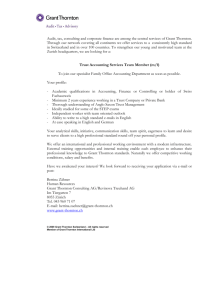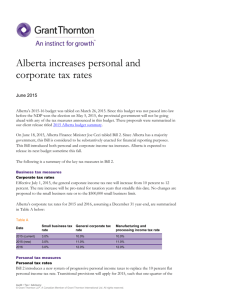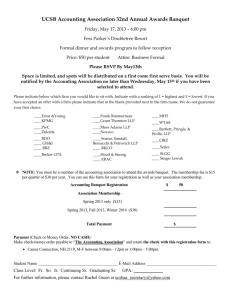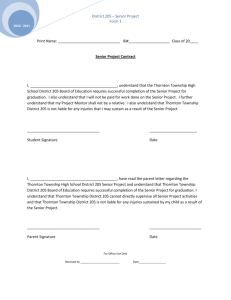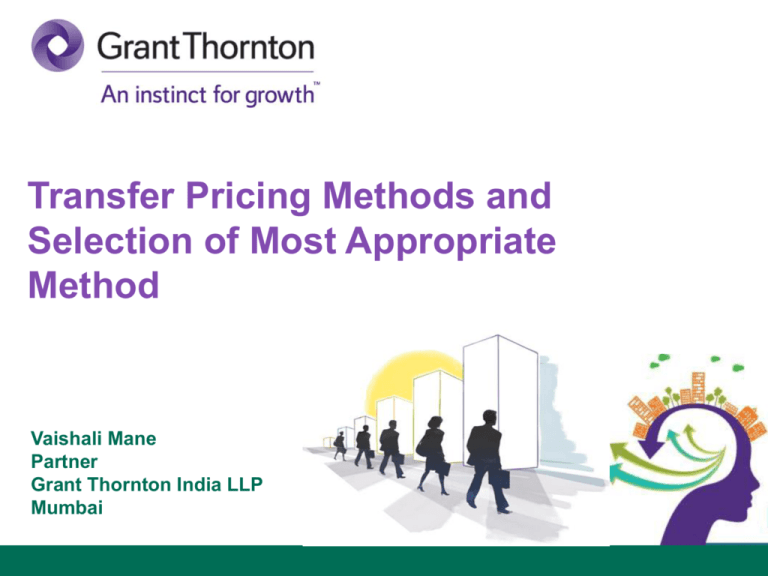
Transfer Pricing Methods and
Selection of Most Appropriate
Method
Vaishali Mane
Partner
Grant Thornton India LLP
Mumbai
Agenda
Transfer Pricing – Quick background
Arm's Length Principle
Overview of Methods
Selection Most Appropriate Method
© Grant Thornton India LLP. All rights reserved.
2
Transfer Pricing –
a quick background
© Grant Thornton India LLP. All rights reserved.
3
Background
•
Transfer Pricing in India introduced with effect from April 1, 2001.
•
Any international transaction undertaken between associated enterprises would be subject to
transfer pricing regulations
•
The term “international transaction” is widely defined to cover almost all kinds of transactions
•
Domestic TP applicable if aggregate value of specified domestic transactions
exceeds INR 5 crores
© Grant Thornton India LLP. All rights reserved.
4
("SDT")
Background
•
Principles governing multinational transfer pricing:
― Arm's length principle
― Global formulary apportionment
•
Arm's length principle most popular globally
•
Arm's length principle requires the transaction between two associated enterprises to be
commercially at par with that of a similar transaction between two independent enterprises
entered in uncontrolled conditions.
•
Transfer pricing methods are mechanism to determine arm's length price
© Grant Thornton India LLP. All rights reserved.
5
Background
Comparability factors for application of arm's length principle
3
Type of
Product
2
1
Accounting
Practices
Functions
Performed
Contractual
Terms
Risk Borne
© Grant Thornton India LLP. All rights reserved.
6
4
5
Background
Comparability Rule
To be comparable means
none of the differences (if any) could materially affect the condition being examined
in the methodology (e.g. price or margin), or
that reasonably accurate adjustments can be made to eliminate effect of any such
differences
Plays a critical role in selection/applicability of methods
© Grant Thornton India LLP. All rights reserved.
7
Overview of TP Methods
© Grant Thornton India LLP. All rights reserved.
8
Transfer Pricing Methods
Comparable Uncontrolled Price
Resale Price Method
Cost Plus Method
Transactional Net Margin Method
Other Method
© Grant Thornton India LLP. All rights reserved.
9
Comparable Uncontrolled Price (CUP) Method
Contents
Introduction and applicability
Types of CUP
Illustration
© Grant Thornton India LLP. All rights reserved.
10
Introduction and applicability
•
compares the price charged from the a property transferred/service provided in a
controlled transaction with the price charged in the comparable uncontrolled
transaction
•
adjustments are required for material differences between the controlled and
uncontrolled transactions which have the potential to affect price in the open market,
•
most direct method and preferred by tax authorities globally
•
CUP can be exact or constructed. constructed CUP tends to arrive at the arm's length price
of a controlled transactions after several adjustments. Quality of constructed CUP relies
on the quality of adjustments
© Grant Thornton India LLP. All rights reserved.
11
Indian TP regulations on CUP
•
Indian regulations provide for selection of most appropriate method
•
Various factors need to be considered to determine most appropriate method
•
Indian regulations do not provide any preference to any particular method
•
CUP still preferred over any other method due to direct comparability
Rule 10B(1)(a):i.
The price charged or paid for property transferred or services provided in a comparable uncontrolled
transaction, or a number of such transactions, is identified;
ii.
Such price is adjusted to account for differences, if any, between the international transaction and the
comparable uncontrolled transactions or between the enterprises entering into such transactions, which
could materially affect the price in the open market.
iii.
The adjusted price arrived at under sub-clause (ii) is taken to be an arm‟s length price (“ALP”) in respect of
the property transferred or services provided in the international transaction
© Grant Thornton India LLP. All rights reserved.
12
Applicability of CUP
•
As per the Transfer Pricing Guidelines issued by the ICAI, typical transaction in which CUP method may be
adopted are:
• Transfer of Goods
• Provision of Services
• Intangibles
• Interest on loans
•
Applicable only when controllable uncontrolled transactions is available in an comparable
environment with adjustable differences.
•
Difficulty in adjusting the material differences does not prohibit the use of CUP.
•
Demands highest degree of product comparability.
•
A valid CUP must correspond to the actual price charged in a controllable uncontrolled transaction in similar
economic circumstances,
•
Any Other Method introduced provides for the use of catalogues, quotations and other indirect evidences
© Grant Thornton India LLP. All rights reserved.
13
OECD Guidelines on CUP
•
As per the Organization for Economic Co-operation and development (“OECD”) guidelines, it is a TP
method which:
•
compares the price charged for property or services transferred in a controlled transaction to the
price charged for property or services transferred in a comparable uncontrolled transaction in
comparable circumstances.
•
CUP method is the most direct and reliable way to apply the arm's length principle.
•
Comparable uncontrolled transaction can be used as CUP if one of the following two conditions is met:
• none of the differences (if any) between the transactions being compared or between the
enterprises undertaking those transactions could materially affect the price in the open market; or
• reasonably accurate adjustments can be made to eliminate the material effects of such
differences.
© Grant Thornton India LLP. All rights reserved.
14
Comparability Factors
Factors to be considered
while selecting comparable
uncontrolled transaction
• Type of Product
• Market levels
• Geographical Market
• Period of Transaction
• Contractual terms
• Economic Conditions
• product similarity
© Grant Thornton India LLP. All rights reserved.
15
Types of CUP
Internal CUP
Co. Y
Co. X
Sells
Co. A
Co. X & Co. Y are associated enterprise (AE) and Co. A is an unrelated party. X sells a common product to
both AE as well as to the non related party.
In this case internal CUP can be applied by comparing the price charged from Co. Y with the price charged
from Co. A. However any contractual difference between the two sale contracts must be adjusted
© Grant Thornton India LLP. All rights reserved.
16
Types of CUP
External CUP
Co. X
Sells
Co. Y
Controlled Transaction
Co. P
Sells
Co. Q
Uncontrolled Transaction
Co. X is engaged in sale of a particular product to its AE, i.e. Co. Y. An unrelated entity, co. P sells the identical
product to Co. Q.
In this case external CUP can be applied by comparing the price charged by Co. X with price charged by Co.
P. However adjustments must be made with regard to any differences in volume, geography contractual terms
© Grant Thornton India LLP. All rights reserved.
17
Resale Price Method (RPM)
Contents
Introduction and applicability
Types of RPM
Application with illustration
Case studies
Judicial Precedents
© Grant Thornton India LLP. All rights reserved.
18
Introduction
•
The resale price method is most appropriate in a situation where the seller adds relatively little
value to the goods.
•
The greater the value-added to the goods by the functions performed by the seller, the more
difficult it will be to determine an appropriate resale margin.
•
This is especially true in a situation where the seller contributes to the creation or maintenance
of an intangible property, such as a marketing intangible, in its activities.
•
While resale price method may require less product comparability, it is a fact that closer
comparability of products will produce better results.
•
The factors to be considered in this method are level of costs, value addition at each stage, timeframe of resale, computation of gross margin, etc.
© Grant Thornton India LLP. All rights reserved.
19
Applicability of RPM
•
Property purchased or services obtained from a related party and resold to an independent
party
•
No major value addition to goods purchased or services obtained from associated
enterprises
•
No intangible assets is applied to add value to the goods resold
•
Most useful in the case of traders & distributors
•
Can easily be applied when no significant value addition is there
•
Not applicable when Goods purchased from AE also sold to AE
© Grant Thornton India LLP. All rights reserved.
20
Indian TP regulations on RPM
Rule 10B(1)(b) :•
The price at which property purchased or services obtained from an AE is resold or provided to
an unrelated enterprise is identified.
•
Such resale price is reduced by the amount of a normal gross profit margin…,
•
in a comparable uncontrolled transaction
•
The price so arrived is further reduced by the expenses incurred by the enterprise in
connection with the purchase…
•
The price so arrived at is adjusted to take into account the functional and other differences,
including differences in accounting practices, if any, which could materially affect the amount of
gross margin in the open market…
© Grant Thornton India LLP. All rights reserved.
21
RPM – Possible Adjustment
•
Inventory Level
•
Contractual Terms
•
Accounting Practices
•
Sales, Marketing, Advertising Programs, and Services
•
The Level of the Market
•
Foreign Currency Risks
© Grant Thornton India LLP. All rights reserved.
22
Illustration - Internal RPM
Internal RPM may be applied when the same reseller is engaged in trading of similar goods in both controlled
and uncontrolled circumstances.
Co. Y
Sells
Co. X
Sells
Co. B
Co. A
In the illustration above Co. X resells the similar goods procured from a related party (Co. Y) and an
unrelated party (Co. A) to an unrelated party (Co. B).
Internal RPM can be applied by comparing the gross profit margin realized on goods procured from Co. Y
with the gross profit margin realized on goods procured from Co. A
© Grant Thornton India LLP. All rights reserved.
23
Illustration - External RPM
External RPM may be applied when an independent party is engaged in trading of similar goods as traded
by tested party in uncontrolled circumstances.
Co. Y
Co. X
Sells
Sells
Co. Y
Controlled Transaction
In the illustration company X resells the goods procured from related party, Co. Y while company P is
reselling the similar goods procured from Co. Q, an unrelated party.
In this case external RPM may be applied by comparing the gross margins realized by Co. P vis-a-vis the
gross margins realized by Co. X
Co. Q
Sells
Co. P
Sells
Uncontrolled Transaction
© Grant Thornton India LLP. All rights reserved.
24
Co. R
Case Study
Facts:-
Distribution
Export of readymade
garments
Customers
ABC Group
Companies
Third Party
Vendors
Indian
Suppliers
• Product
Development
• Quality Control
• Marketing
• Distribution
• Customer Billing
• Overall group
management
Procures
Raw Materials
ABC India
ABC Group
• Manufacture and sale of readymade
garments
• Its subsidiaries also produce and sell of
readymade garments under ABC brands,
licensed brands, private labels, and store
brands.
ABC India
• Joint Venture of ABC US and Indian third
parties
• Raw Material
Procurement
• Manufacturing
• Quality Control
• Marketing
• Packaging
• Export
• Manufacturing and Exporting garments to
ABC Group Companies
• ABC India exports primarily to ABC Group
co's.
• It has net level losses
© Grant Thornton India LLP. All rights reserved.
25
Case Study
International Transactions
Economic Characterization
1.
Manufacturing and Exports of readymade
garments
ABC India :- Routine manufacturer operating
independently
ABC US :- ABC US acts as a distributor.
(Principle risk bearing entity, carrying business
activities involving sales and marketing of
garments)
© Grant Thornton India LLP. All rights reserved.
26
Case Study
Most Appropriate Method
Internal Resale Price Method
Approach
ABC US as a tested party
Comparison of Gross Profit margin of ABC
US earns from the following transactions:
© Grant Thornton India LLP. All rights reserved.
•
ABC US and ABC India
•
ABC US and third parties in Asia
27
Case Study
Internal RPM
Customer
ABC US
GP margin
from ABC
India
GP margin from
third party
ABC
India
Third party
Vendors
GP margin from India <= GP margin from third party = ALP
© Grant Thornton India LLP. All rights reserved.
28
Judicial Precedent
ITO vs. L’Oreal India P. Ltd
(5423/Mum/2009)
Facts of the case
•
L'Oreal India is engaged in the business of manufacture
and distribution of cosmetics and beauty products.
•
AE
L'Oreal India had two business (i) manufacture and (ii)
distribution.
•
L'Oreal India adopted RPM to benchmark its international
transaction pertaining to purchase of finished goods for
Outside India
India
distribution in India.
Purchase of
finished goods
L'Oreal India
Customers
Sale of finished
goods
© Grant Thornton India LLP. All rights reserved.
29
RPM – Key Judgment
TPO's Contention
•
The TPO rejected the RPM adopted by L'Oreal India, on the grounds that L'Oreal India's pricing policy is not
at arm‟s length since it is consistently incurring losses.
•
He proposed an adjustment by applying TNMM
•
The TPO also observed that the comparable's gross margins cannot be relied upon because of product
differences, and that the FAR comparison of L'Oreal India vis-à-vis comparable companies is sufficient only
for application of TNMM and not RPM.
CIT's Contentions
•
The CIT(A) deleted the entire addition made by the TPO and considered taxpayer‟s contentions
•
Reliance was placed on the OECD guidelines and guidance note issued by ICAI.
© Grant Thornton India LLP. All rights reserved.
30
RPM – Key Judgment
ITAT Judgment
•
The Tribunal agreed with the CIT(A) that there is no order of priority of methods to determine ALP.
•
The Tribunal observed that RPM, being one of the standard methods, is the most appropriate method for
distributing and marketing activities when the goods are purchased from AEs and resold to unrelated parties.
•
The Tribunal also noted that this view was supported by OECD guidelines.
© Grant Thornton India LLP. All rights reserved.
31
RPM – Key Judgment
The main grounds before the High Court and its verdict are as under:
Whether the Tribunal erred in holding that
RPM was the most appropriate method for
determining ALP in respect of imports of
finished goods
There no distinguishing features were
noted, the Tribunal did not err in holding
that RPM was the most appropriate
method for determining ALP in respect of
imports of finished goods.
Whether the Tribunal erred in not appreciating
that the substantial value addition made to the
goods has changed the degree of similarity in the
functions performed thereby making RPM non
applicable in the instant case
The High Court observed that the Tribunal, in its
order, has noted that RPM can be adopted in case of
distribution or marketing activities when the goods
are purchased from associated entities and there are
sales effected to unrelated parties without any further
processing. The same view is also supported by
OECD guidelines and accordingly, the Tribunal did
not err in holding that RPM is the most appropriate
method for the international transactions in respect
of import of finished goods.
© Grant Thornton India LLP. All rights reserved.
32
Cost Plus Method
Contents
Introduction and applicability
Types of CPM
Application with illustration
Case studies
© Grant Thornton India LLP. All rights reserved.
33
Cost Plus Method
•
CPM is applicable in the case of manufacturers or service providers engaged in supply of a
property or provision of services to its related party
•
CPM compares the gross profit mark-up on the costs incurred by the tested party in the supply
of property or provision of services to the related party with the gross profits realized on supply
of similar property or provision of similar services by the tested party/comparable entities in
uncontrolled transactions
•
Under CPM Arm's Length Price ("ALP") is computed as:
ALP =
Direct and indirect cost of production in respect of property transferred or
service provided
(+) Gross profit mark-up earned in comparable uncontrolled transaction
(+) / (-) Adjustments for differences which would materially affect the gross profit
margins in open market
© Grant Thornton India LLP. All rights reserved.
34
Indian TP regulations on CPM
Rule 10B(1)(c)
i.
the direct and indirect costs of production incurred by the enterprise in respect of
property transferred or services provided to an associated enterprise, are determined;
ii.
the amount of a normal gross profit mark-up to such costs (computed according to the
same accounting norms) arising from the transfer or provision of the same or similar
property or services by the enterprise, or by an unrelated enterprise, in a comparable
uncontrolled transaction, or a number of such transactions, is determined
iii.
the normal gross profit mark-up referred to in sub-clause (ii) is adjusted to take into
account the functional and other differences, if any, between the international
transaction and the comparable uncontrolled transactions, or between the enterprises
entering into such transactions, which could materially affect such profit mark-up in the
open market;
iv.
the costs referred to in sub-clause (i) are increased by the adjusted profit mark-up
arrived at under sub-clause (iii);;
v.
the sum so arrived at is taken to be an arm's length price in relation to the supply of the
property or provision of services by the enterprise;
© Grant Thornton India LLP. All rights reserved.
35
Applicability of CPM
•
Supply of a property or provision of services to a related party
•
Most useful in the case of transfer of semi finished goods, where long term arrangements
have been entered between related parties, provision of services
•
Not applicable in the case of receipt of a property or receipt of services from related party
© Grant Thornton India LLP. All rights reserved.
36
Key Aspects in application
There must be a consistency in cost base
between controlled and uncontrolled
transactions, specially in the
circumstances where costs have the effect
on the size of mark-up
As the term direct and indirect costs of
production are not defined anywhere, it
may be difficult to determine the costs
especially for the comparable
uncontrolled transactions
© Grant Thornton India LLP. All rights reserved.
Accounting inconsistencies must be
eliminated between controlled and
uncontrolled transactions.
37
Key Aspects in application
concentrates on functional similarities. Risk
profile must be similar between controlled and
uncontrolled transactions. Internal comparables
more reliable
Fewer adjustments required on account of
product differences than CUP. Less vitiated by
indirect expenses
© Grant Thornton India LLP. All rights reserved.
38
Key Aspects in application
•
Appropriate adjustments required to eliminate material differences
•
Some illustrative adjustments:
―
Inventory levels and turnover rates;
―
Sales, marketing and advertising programs;
―
level of market
―
Accounting practices
―
contractual terms
―
tangible and intangible assets
© Grant Thornton India LLP. All rights reserved.
39
Types of CPM – Internal CPM
Internal CPM may be applied when the same reseller is engaged in trading of similar goods in both controlled
and uncontrolled circumstances.
Co. A
Co. X
manufactures
Sells
Co. Y
In the illustration above Co. X manufactures a certain commodity and supplies the same both to the related
party (Co. Y) and unrelated party (Co. A)
Internal CPM can be applied by comparing the gross profit margin realized on goods supplied to Co. Y with the
gross profit margin realized on goods supplied to Co. A
© Grant Thornton India LLP. All rights reserved.
40
Types of CPM – External CPM
External CPM may be applied when an independent party is engaged in manufacture and supply of similar
products as supplied by tested party in uncontrolled circumstances.
In the illustration company X is supplying the goods to related party, Co. Y while company P is supplying the
goods to Co. Q, an unrelated party.
In this case external CPM may be applied by comparing the gross markup realized by Co. P vis-a-vis the
gross markup realized by Co. X
Co. X
manufacture and
supply
Co. A
Controlled Transaction
Co. Q
Co. P
manufacture and
supply
Uncontrolled Transaction
© Grant Thornton India LLP. All rights reserved.
41
Profit Split Method (PSM)
Contents
Introduction
Types of PSM
Strength and Weakness
Judicial precedents-global
© Grant Thornton India LLP. All rights reserved.
42
Introduction
•
PSM determines arm‟s length profit based on combined profits derived by related
parties
•
PSM is relevant
– where different related parties are doing typical activity in value chain and
external
– comparable with similar FAR is difficult to apply
•
Sharing of non-routine assets or entrepreneurial risks
© Grant Thornton India LLP. All rights reserved.
43
Indian TP regulations on PSM
Rule 10B(1)(d)
i. the combined net profit of the associated enterprises arising from the
international transaction in which they are engaged, is determined;
ii. the relative contribution made by each of the associated enterprises to the
earning of such combined net profit, is then evaluated on the basis of the
functions performed, assets employed or to be employed and risks assumed by
each enterprise and on the basis of reliable external market data which
indicates how such contribution would be evaluated by unrelated enterprises
performing comparable functions in similar circumstances;
iii. the combined net profit is then split amongst the enterprises in proportion to
their relative contributions, as evaluated under sub-clause (ii);
iv. the profit thus apportioned to the assessee is taken into account to arrive at
an arm‟s length price in relation to the international transaction
© Grant Thornton India LLP. All rights reserved.
44
Types of PSM
Residual
Analysis
© Grant Thornton India LLP. All rights reserved.
Contribution
Analysis
45
Types of PSM
Residual Profit Split Method
•
The residual profit, i.e., portion of the profit attributable to the entrepreneurial, non-routine or residual
functions is split based on the profit split principles.
•
There is a characterization of functions, risks and assets to routine and non-routine, wherein the routine
functions are considered to be relatively simple and for which the comparable market data is easily
available.
•
The profit is attributed to the routine functions and the arm‟s length character is first applied to this part of
the profit.
•
The residual profit, if attributable to the non-routine / entrepreneurial functions is split on the basis as
considered appropriate depending on the character of the profit
•
A common issue with this method is that there is often a very thin line between routine and nonroutine
functions, risks and assets.
•
This method is the most commonly used profit split method, particularly popular in automotive, consumer
electronics and financial services industries.
© Grant Thornton India LLP. All rights reserved.
46
PSM – Strengths and weakness
Strengths
•
Weakness
Offers solutions for integrated
operations not offered by one-sided
methods
• Difficulty in application
•
Helps share profits for unique
intangibles contributed
• Allocation of costs
•
Less dependant on comparables
• Reluctance of tax authorities to
accept
•
Less likely to leave any party to the
transaction with extreme profitability
as both parties are evaluated
© Grant Thornton India LLP. All rights reserved.
• Necessitating application of similar
accounting policies and standards
• Voluminous data
47
Judicial precedents-global
GSK settles largest tax dispute in history for $3.1bn
US - marketing
subsidiaries
Profit
allocation
UK - developer and
manufacturer
How much of the product's value should be attributed to each jurisdiction?
© Grant Thornton India LLP. All rights reserved.
48
Transactional Net Margin Method
Contents
Introduction and applicability
Strength and Weakness
© Grant Thornton India LLP. All rights reserved.
49
Introduction
•
Generally the default method for use in the absence sufficient info for other
methods
•
Comparison at operating margin level
•
Comparison at transactional level, where possible
•
Test the simplest party
•
Broad level of similarity of FAR
•
Selection of the right comparables and PLI are critical factors
•
Most preferred and practical method
© Grant Thornton India LLP. All rights reserved.
50
Indian TP regulations TNMM
Rule 10B(1)(e)
i.
the net profit margin realized by the enterprise from an international transaction entered into with an
associated enterprise is computed in relation to costs incurred or sales effected or assets
employed or to be employed by the enterprise or having regard to any other relevant base
ii.
the net profit margin realized by the enterprise or by an unrelated enterprise from a comparable
uncontrolled transaction or a number of such transactions is computed having regard to the same
base.
iii.
the net profit margin referred to in sub-clause (ii) arising in comparable uncontrolled transactions
is adjusted to take into account the differences, if any, between the international transaction and the
comparable uncontrolled transactions, or between the enterprises entering into such transactions, which
could materially affect the amount of net profit margin in the open market.
iv.
the net profit margin realized by the enterprise and referred to in sub-clause (i) is established to be
the same as the net profit margin referred to in sub-clause (iii)
v.
the net profit margin thus established is then taken into account to arrive at an arm’s length price in
relation to the international transaction.
© Grant Thornton India LLP. All rights reserved.
51
Applicability - TNMM
•
No specific guidance is provided on when this method is reliable except rule 10C(2)
•
However typical transactions in respect of which the Transactional Net Margin method may be
adopted are:
•
Transfer of goods
Provision of services
Purchase of goods
Factors of Comparability to be considered while selecting TNMM
Functions Performed (taking into account assets used and risks assumed)
Contractual terms
Conditions prevailing in the markets, location, laws in force etc.
Business Strategies
© Grant Thornton India LLP. All rights reserved.
52
Applicability - TNMM
How it is applied?
Nature of International Transactions
FAR Analysis
Characterization of entities, selection of tested party,
selection of Most Appropriate Method, functional and
product characteristics of the uncontrolled comparable
companies
If two or more Comparable
Companies are selected, arithmetic
mean would establish the arm’s
length price.
Economic Analysis and arriving at net margin of CC
Adjustment of the above net margin for transaction level /
company level differences on the basis of FAR analysis
Adjusted net margin is used for Benchmarking International
Transactions
© Grant Thornton India LLP. All rights reserved.
53
TNMM – Strength and Weakness
Strengths
•
Net profit indicators are less affected by transactional differences than is the case with
price, as used in the CUP method.
•
Net profit indicators are also more tolerant to some functional differences between the
controlled and uncontrolled transactions than gross profit margins.
Weaknesses
•
Information on uncontrolled transactions may not be available at the time of the
controlled transactions.
•
Difficulties in determining an appropriate corresponding adjustment when applying the
transactional net margin method.
© Grant Thornton India LLP. All rights reserved.
54
Other Method
© Grant Thornton India LLP. All rights reserved.
55
Other Method
•
Any method which takes into account:
-
the price which has been charged or paid,
-
or would have been charged or paid,
-
for the same or similar uncontrolled transaction, with or between nonassociated enterprises, under similar circumstances, considering all the
relevant facts
© Grant Thornton India LLP. All rights reserved.
56
The Methods - Snapshot
Turnover
(Cost of sales)
Comparable Uncontrolled Price
Gross profit
(administration, Marketing,
Selling and Distribution
expenses)
Operating profit
Resale Price Method
TNM Method
Price charged / paid or proposed
© Grant Thornton India LLP. All rights reserved.
57
Cost Plus Method
Profit Split Method
Selection of Most Appropriate
Method
© Grant Thornton India LLP. All rights reserved.
58
Most Appropriate Method
•
„Most appropriate method‟ is method best suited to facts and circumstances,
providing most reliable measure of ALP
•
„Most appropriate method‟ to be selected having regard to the following factors:
-
Nature and class of international transaction
-
Functions performed, assets utilized, risks assumed
-
Availability and reliability of data
-
Degree of comparability between controlled and uncontrolled
transactions
-
Possibility to make reliable and accurate adjustments
-
Nature, extent and reliability of assumptions required
© Grant Thornton India LLP. All rights reserved.
59
Choice of Transfer Pricing Method: Economic
determinants
Product
Similarity
CUP method
Resale Price
Cost Plus
Traditional methods
Profit based methods
TNMM
Residual Profit Split
© Grant Thornton India LLP. All rights reserved.
60
Functional
Similarity
Intangible
presence
Questions and
Answers
© Grant Thornton India LLP. All rights reserved.
61
Thank you
© Grant Thornton India LLP. All rights reserved.
62

